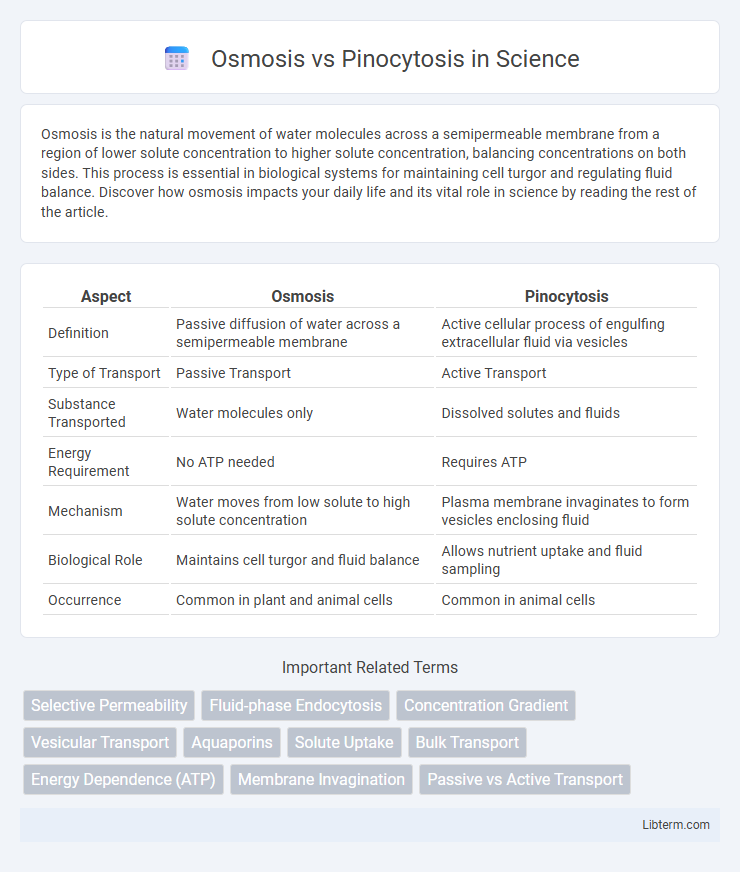Osmosis is the natural movement of water molecules across a semipermeable membrane from a region of lower solute concentration to higher solute concentration, balancing concentrations on both sides. This process is essential in biological systems for maintaining cell turgor and regulating fluid balance. Discover how osmosis impacts your daily life and its vital role in science by reading the rest of the article.
Table of Comparison
| Aspect | Osmosis | Pinocytosis |
|---|---|---|
| Definition | Passive diffusion of water across a semipermeable membrane | Active cellular process of engulfing extracellular fluid via vesicles |
| Type of Transport | Passive Transport | Active Transport |
| Substance Transported | Water molecules only | Dissolved solutes and fluids |
| Energy Requirement | No ATP needed | Requires ATP |
| Mechanism | Water moves from low solute to high solute concentration | Plasma membrane invaginates to form vesicles enclosing fluid |
| Biological Role | Maintains cell turgor and fluid balance | Allows nutrient uptake and fluid sampling |
| Occurrence | Common in plant and animal cells | Common in animal cells |
Introduction to Cellular Transport Mechanisms
Osmosis and pinocytosis are essential cellular transport mechanisms facilitating the movement of substances across cell membranes. Osmosis involves the passive diffusion of water molecules through a selectively permeable membrane from an area of lower solute concentration to higher solute concentration, maintaining cellular homeostasis. Pinocytosis is an active transport process where cells engulf extracellular fluid and dissolved solutes by forming vesicles, enabling the intake of necessary nutrients and signaling molecules.
Defining Osmosis: The Basics
Osmosis is the passive movement of water molecules across a semipermeable membrane from an area of lower solute concentration to higher solute concentration, aiming to equalize solute levels on both sides. This process is vital for maintaining cellular homeostasis and regulating fluid balance within cells. Unlike pinocytosis, which involves active engulfment of extracellular fluid, osmosis strictly relies on molecular diffusion driven by concentration gradients.
Understanding Pinocytosis: Cell Drinking Explained
Pinocytosis is a cellular process where the cell engulfs extracellular fluid and dissolved solutes by forming small vesicles, often referred to as "cell drinking." This mechanism enables cells to intake nutrients and fluids that cannot pass directly through the membrane, differentiating it from osmosis, which involves passive water movement through a semipermeable membrane. Pinocytosis plays a crucial role in maintaining cellular homeostasis by regulating fluid balance and nutrient absorption in various cell types.
Key Differences Between Osmosis and Pinocytosis
Osmosis is the passive movement of water molecules across a semi-permeable membrane from a region of low solute concentration to high solute concentration, while pinocytosis is an active cellular process where cells engulf extracellular fluid and dissolved solutes through membrane invagination. Osmosis does not require energy and involves only water, whereas pinocytosis consumes ATP and transports a variety of solutes within vesicles. The primary difference lies in osmosis being a passive diffusion process specific to water, contrasted with pinocytosis being an energy-dependent endocytic mechanism for bulk intake of fluids.
Mechanisms of Molecular Movement in Osmosis
Osmosis involves the passive movement of water molecules across a semipermeable membrane from an area of lower solute concentration to higher solute concentration to achieve equilibrium. This movement occurs without energy input, driven purely by the concentration gradient, enabling cells to regulate their internal environment. In contrast, pinocytosis requires energy as cells actively engulf extracellular fluid and dissolved solutes through vesicle formation.
The Process of Pinocytosis in Cells
Pinocytosis is a cellular process where cells engulf extracellular fluid and dissolved solutes by invaginating the plasma membrane to form small vesicles. This active transport mechanism allows cells to selectively intake nutrients and signaling molecules in a controlled manner, involving energy consumption through ATP hydrolysis. Unlike osmosis, which is passive water movement across a semipermeable membrane, pinocytosis requires cytoskeletal rearrangement and vesicle trafficking for internalization.
Biological Significance of Osmosis
Osmosis plays a crucial role in maintaining cellular homeostasis by regulating the movement of water across semipermeable membranes, ensuring proper cell volume and turgor pressure. Unlike pinocytosis, which involves the energy-dependent intake of extracellular fluids and molecules, osmosis operates passively to balance solute concentrations between intracellular and extracellular environments. This process is vital for nutrient absorption, waste removal, and preventing cellular dehydration or swelling in both plant and animal cells.
Functional Roles of Pinocytosis in Living Organisms
Pinocytosis enables cells to ingest extracellular fluids and dissolved solutes, playing a critical role in nutrient uptake and cellular communication. Unlike osmosis, which regulates water movement across membranes, pinocytosis actively transports macromolecules and ions into the cell through vesicle formation. This process supports essential physiological functions such as nutrient absorption, immune responses, and maintaining cellular homeostasis.
Comparative Table: Osmosis vs. Pinocytosis
The comparative table of osmosis versus pinocytosis highlights osmosis as the passive movement of water molecules across a semipermeable membrane from low to high solute concentration, while pinocytosis is an active cellular process involving the engulfment of extracellular fluid into vesicles. Osmosis is crucial for maintaining cell turgor and fluid balance, whereas pinocytosis supports nutrient uptake and membrane recycling. Key differences include energy requirement, with osmosis being energy-independent and pinocytosis dependent on ATP, and the scale of transported materials, ranging from water molecules in osmosis to larger fluid volumes in pinocytosis.
Conclusion: Choosing the Right Transport Mechanism
Selecting the appropriate transport mechanism depends on the specific cellular needs: osmosis efficiently regulates water balance by moving water through semipermeable membranes, while pinocytosis actively engulfs extracellular fluids and solutes via vesicle formation. Osmosis is critical for maintaining cell turgor and homeostasis in hypotonic or hypertonic environments, whereas pinocytosis facilitates nutrient intake and cellular signaling in more complex environments. Understanding the differences in energy use, selectivity, and speed helps determine whether passive water transport or active fluid uptake best suits physiological demands.
Osmosis Infographic

 libterm.com
libterm.com